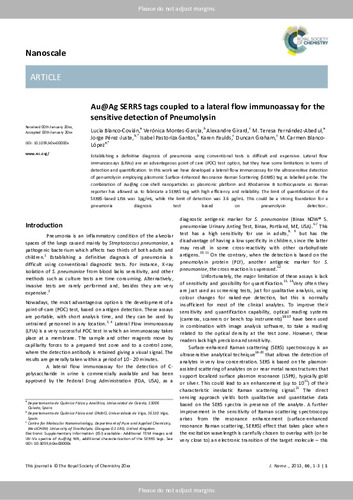Au@Ag SERRS tags coupled to a lateral flow immunoassay for the sensitive detection of pneumolysin
Publication date:
Editorial:
Royal Society of Chemistry
Publisher version:
Citación:
Descripción física:
Abstract:
Establishing a definitive diagnosis of pneumonia using conventional tests is difficult and expensive. Lateral flow immunoassays (LFIAs) are an advantageous point of care (POC) test option, but they have some limitations in terms of detection and quantification. In this work we have developed a lateral flow immunoassay for the ultrasensitive detection of penumolysin employing plasmonic Surface-Enhanced Resonance Raman Scattering (SERRS) tag as labelled probe. The combination of Au@Ag core-shell nanoparticles as plasmonic platform and Rhodamine B Isothiocyanate as Raman reporter has allowed us to fabricate a SERRS tag with high efficiency and reliability. The limit of quantification of the SERRS-based LFIA was 1pg/mL, while the limit of detection was 3.6 pg/mL. This could be a strong foundation for a pneumonia diagnosis test based on pneumolysin detection
Establishing a definitive diagnosis of pneumonia using conventional tests is difficult and expensive. Lateral flow immunoassays (LFIAs) are an advantageous point of care (POC) test option, but they have some limitations in terms of detection and quantification. In this work we have developed a lateral flow immunoassay for the ultrasensitive detection of penumolysin employing plasmonic Surface-Enhanced Resonance Raman Scattering (SERRS) tag as labelled probe. The combination of Au@Ag core-shell nanoparticles as plasmonic platform and Rhodamine B Isothiocyanate as Raman reporter has allowed us to fabricate a SERRS tag with high efficiency and reliability. The limit of quantification of the SERRS-based LFIA was 1pg/mL, while the limit of detection was 3.6 pg/mL. This could be a strong foundation for a pneumonia diagnosis test based on pneumolysin detection
DOI:
Patrocinado por:
This work was supported by the Ministerio de Economía y Competitividad (MINECO, Spain), under the Grant CTQ2013-47396-R, CTQ2014-58826-R, MAT2013-45168-R and MAT2016-77809-R. This study was also financed by the Consejería de Economía y Empleo del Principado de Asturias (Plan de Ciencia, Tecnología e Innovación 2013–2017), under the Grant GRUPIN14-022 and FC-15-GRUPIN14-021. V. M.-G. acknowledges FPU scholarship from the Spanish MINECO. A. G. acknowledges EPSRC (Engineering and Physical Sciences Research Council).
Collections
- Artículos [37541]
- Investigaciones y Documentos OpenAIRE [8416]
- Química Física y Analítica [639]
Files in this item




